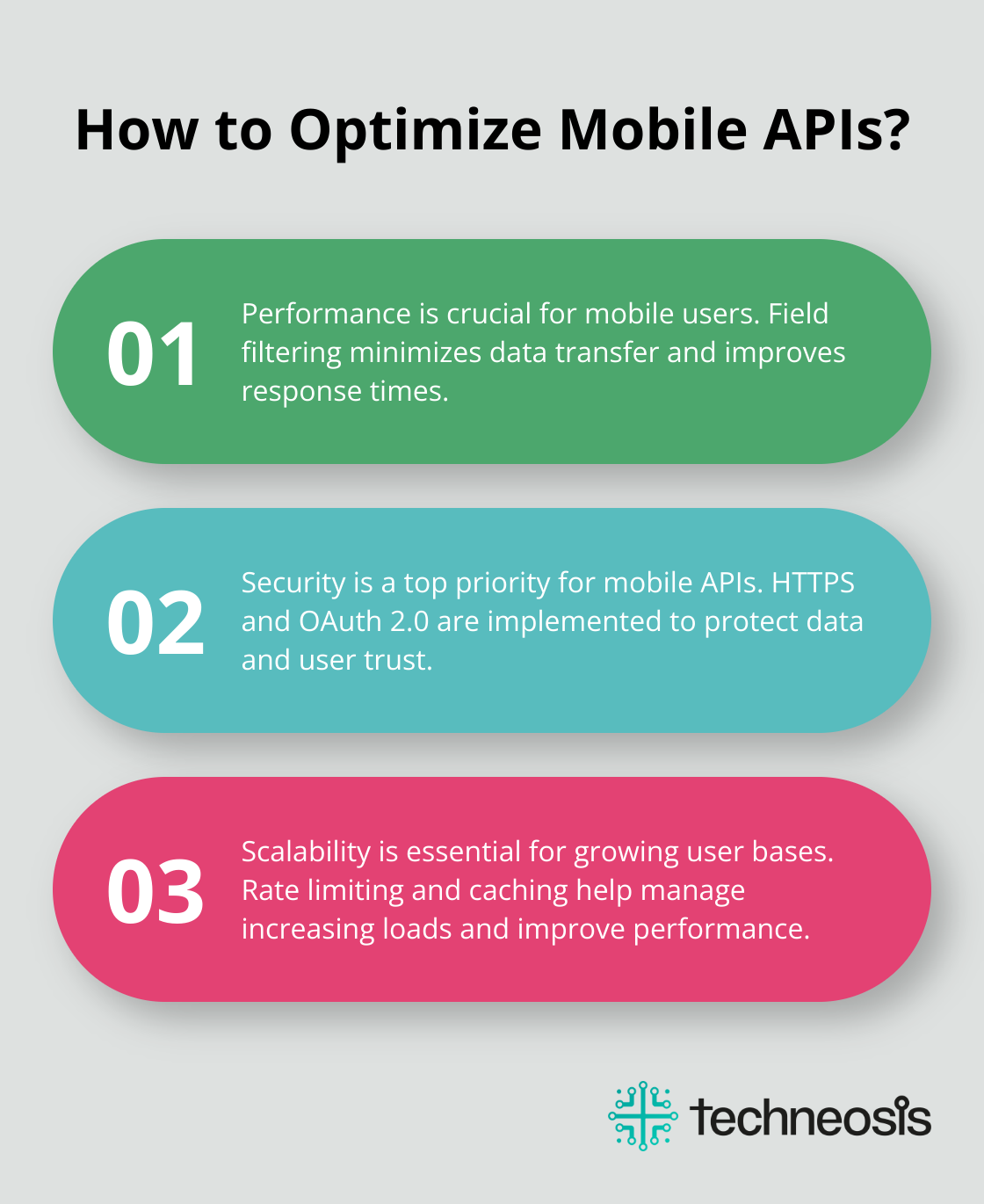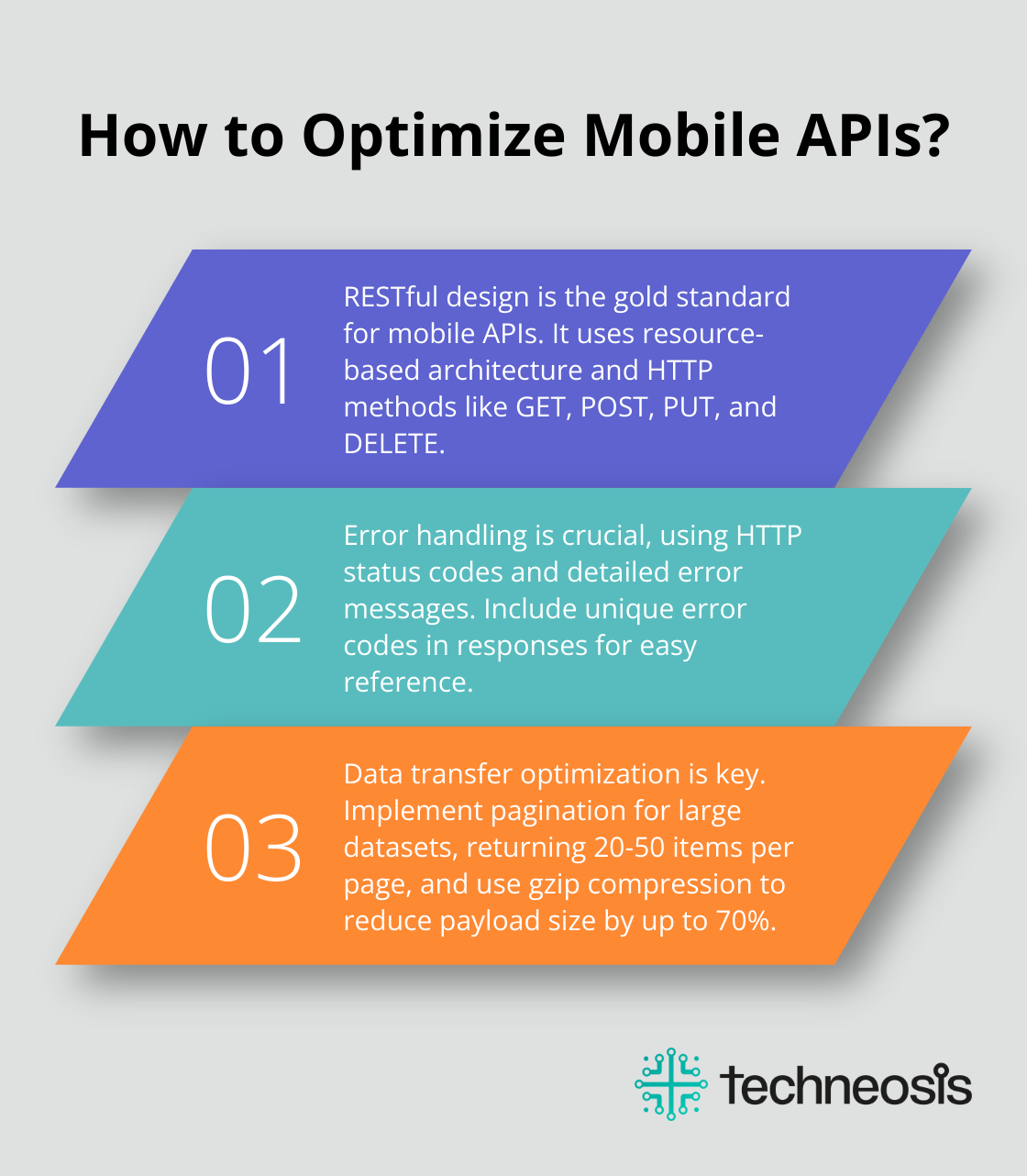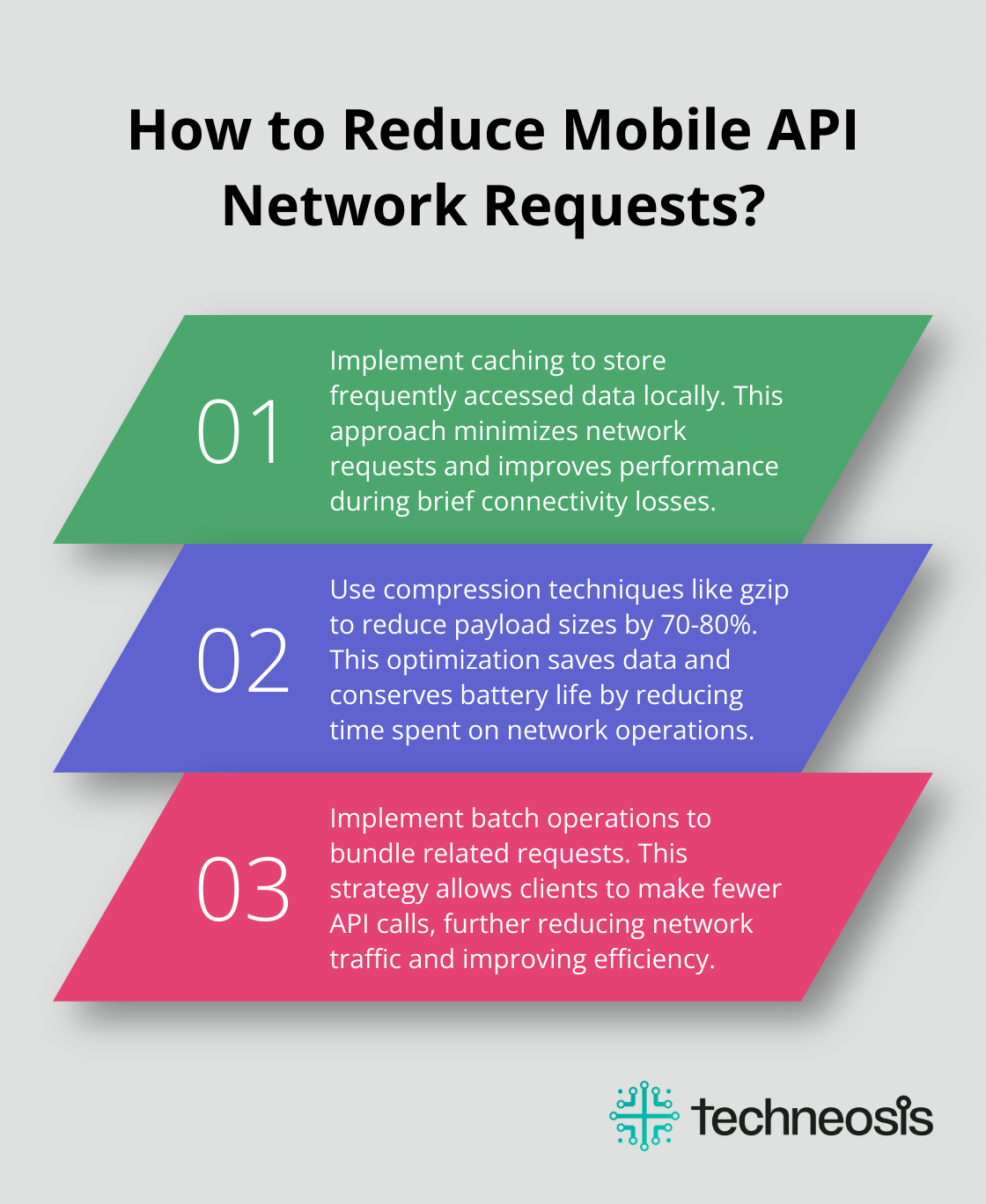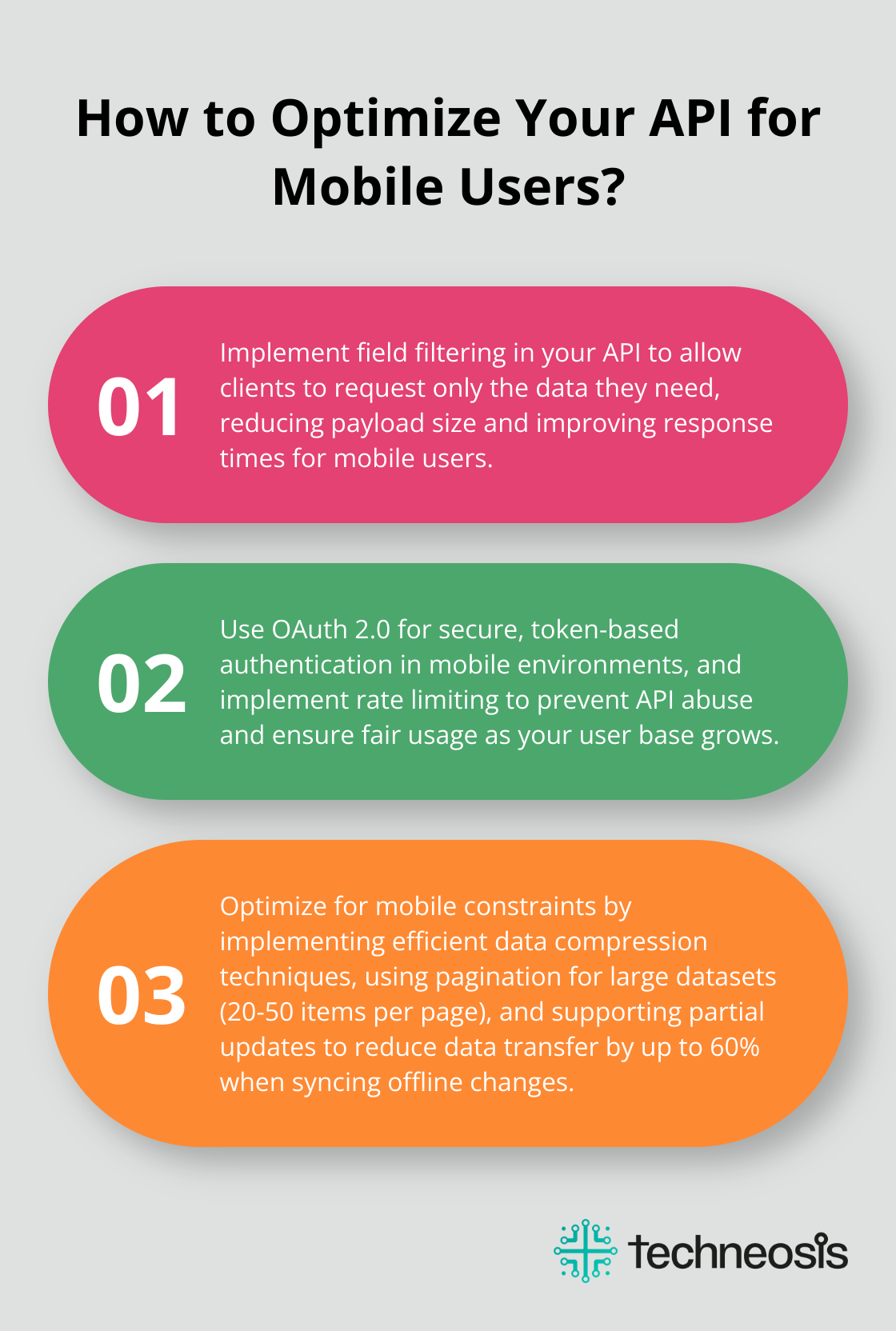In this post, we’ll explore key principles and best practices for creating effective mobile app web APIs. We’ll also address common challenges developers face and look at future trends shaping this essential aspect of mobile development.
How to Design Effective Mobile APIs
Performance is King
Mobile users demand lightning-fast responses. To meet this expectation, we minimize data transfer through field filtering. This approach allows clients to request only the data they need, which reduces payload size and improves response times. For instance, instead of sending all user details, the app specifies which fields it requires.
Security: A Top Priority
Security breaches can destroy user trust and business reputation. We implement HTTPS to encrypt data in transit. OAuth 2.0 provides a secure, token-based approach that’s ideal for mobile environments. It’s essential to validate all input on the server-side to prevent injection attacks.
Build for Scalability
Your API should handle increasing loads as your user base grows. Rate limiting helps prevent abuse and ensures fair usage. Caching frequently accessed data can significantly reduce server load and improve response times.
Consistency Drives Adoption
A consistent API design simplifies integration for developers. We follow REST principles for resource naming and use standard HTTP methods (GET, POST, PUT, DELETE) for operations. Using a consistent date format (such as ISO 8601) and timezone standard (typically UTC) across all endpoints avoids confusion.
Optimize for Mobile Constraints
Mobile devices often operate in challenging network conditions. Design your API to handle intermittent connectivity gracefully. Implement efficient data compression techniques to reduce bandwidth usage. Consider offering offline functionality where possible to enhance user experience in low-connectivity situations.

These principles form the foundation of effective mobile API design. In the next section, we’ll explore best practices that will help you implement these principles effectively in your mobile API development process.
How to Build Robust Mobile APIs
At Techneosis, we understand that building effective mobile APIs requires a blend of technical expertise and user-centric design. Here’s what works best:
Embrace RESTful Design
RESTful architecture stands as the gold standard for mobile APIs. The key principles include statelessness, uniform interface, resource-based architecture, self-descriptive messages, and hypermedia. We structure our APIs around resources, not actions. For example, we use /users/{id} instead of /getUser. This approach makes our APIs more intuitive and easier to use.

We also use HTTP methods to their full potential:
- GET for retrieving data
- POST for creating new resources
- PUT for updating existing ones
- DELETE for removing resources
This consistency makes our APIs predictable and easier to work with.
Master Error Handling
Error handling strategies are crucial for effective APIs. Common approaches include input validation to check data integrity, defensive programming to anticipate potential issues, and retry mechanisms. We use standard HTTP status codes to indicate the outcome of requests (200 for success, 400 for bad requests, 500 for server errors). We also include detailed error messages in the response body to help developers quickly identify and fix issues.
Pro tip: Include a unique error code in your responses. This allows developers to easily reference specific errors in your documentation or when seeking support.
Optimize Data Transfer
Mobile networks can be unreliable and data plans expensive. We focus on minimizing data transfer. We implement pagination for large datasets, typically returning 20-50 items per page. This approach significantly reduces load times and data usage.
Compression serves as another powerful tool in our arsenal. Using gzip compression, we’ve observed payload size reductions of up to 70% in some cases. This not only speeds up data transfer but also reduces battery drain on mobile devices.
Create Clear Documentation
Even the best-designed API becomes useless without good documentation. We provide comprehensive, up-to-date documentation for all our APIs. This includes detailed descriptions of each endpoint, request and response formats, and example requests and responses.
Interactive documentation tools (like Swagger UI) can significantly improve the developer experience. They allow developers to test API calls directly from the documentation, speeding up integration and reducing errors.
Your API is a product, and documentation serves as its user manual. Invest time in creating clear, concise, and helpful documentation. It will pay off in reduced support requests and happier developers.
Now that we’ve covered the essentials of building robust mobile APIs, let’s explore how to overcome common challenges in mobile app development.
How to Overcome Mobile API Design Challenges
Tackle Network Instability
Mobile networks often fail. We implement robust error handling and retry mechanisms to combat this issue. Our APIs use exponential backoff algorithms for retries, which reduce server load during outages. This approach has cut failed requests by up to 30% in areas with poor connectivity.

We also use caching aggressively. By storing frequently accessed data locally, we minimize network requests. This improves performance and enhances the user experience during brief connectivity losses.
Ensure Seamless Updates
Version control and backwards compatibility are essential for mobile APIs. We use semantic versioning (SemVer) to communicate changes clearly. Major version updates (e.g., v1 to v2) signal breaking changes, while minor updates (e.g., v1.1 to v1.2) add features without breaking existing functionality.
To maintain backwards compatibility, we never remove fields from our API responses. Instead, we deprecate them and introduce new fields. This allows older app versions to continue functioning while newer versions can use improved data structures.
Balance Online and Offline Functionality
Modern mobile apps must work seamlessly both online and offline. We achieve this balance through local storage and synchronization strategies. Our APIs support partial updates, allowing apps to sync only changed data when connectivity returns. This approach has reduced data transfer by up to 60% in some projects.
We also implement conflict resolution mechanisms. When offline changes conflict with server-side updates, our APIs provide clear resolution paths (often favoring server-side data but allowing client-side overrides when necessary).
Optimize for Battery and Data Usage
Mobile devices have limited battery life and often restricted data plans. We design our APIs with efficiency in mind. We use compression techniques like gzip, which typically reduces payload sizes by 70-80%. This saves data and reduces time spent on network operations, conserving battery life.
We also implement batch operations where possible. Instead of making multiple API calls for related actions, we allow clients to bundle requests.
By focusing on these back-end development best practices, we can create efficient, scalable, and high-performing mobile APIs that enhance the overall success of the app.
Final Thoughts
Effective mobile app Web API design requires a balance of performance, security, and scalability. We prioritize RESTful architecture, robust error handling, and optimized data transfer to create APIs that meet mobile environment demands. Clear documentation proves essential for smooth integration and reduced developer frustration.

Mobile API design faces unique challenges such as network instability and battery constraints. We implement strategies like efficient caching, versioning, and offline functionality to provide seamless experiences in various conditions. These approaches help create APIs that drive innovation and deliver exceptional mobile experiences.
At Techneosis, we help businesses navigate mobile app development complexities. Our expertise in strategic technology solutions ensures optimized mobile APIs for long-term success. We continuously improve based on user feedback and performance metrics to maintain effective mobile app Web APIs.



